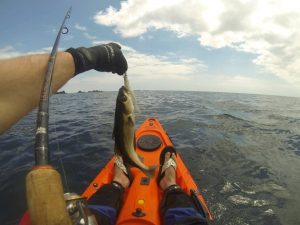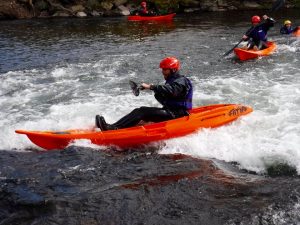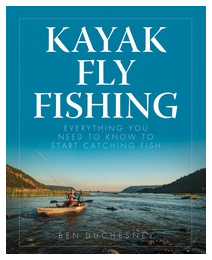How to fish from a Kayak?

Kayak fishing is gaining much popularity in Europe and America.
Kayak fishing is a fast growing sport in both Europe and America. Many benefits include being able to move around more easily (and silently) to find the perfect fishing spot, as well as getting much closer to your catch in comparison to wading or fishing from the shore. As with regular fishing, there are many methods to fish from a kayak. Here are some of the most popular:
Fly Fishing (or “Flyaking!)
Fishing for... Bass, Mackerel, Mullet, Trout
Learn More
Kayak Fly Fishing, by Ben Duchesney
If you are interested to know everything there is to know about Kayak Fly Fishing, then this book might be of interest to you. It has a in-depth section about technique as well as going into a lot of detail about the specific gear required.
Click here to buy.

Kayak fishing requires skill and patience, but is highly rewarding and can turn into an addictive sport once you get a few bites!
Ledgering
Fishing for….Bream, Barbel, Tench, Catfish & Carp (bottom feeding fish)
Legering is a method anglers use in fishing a static bait on the bottom of a lake or river bed.
It doesn’t use a float (unless you are float ledgering) but consists of using a weight on the main line and other methods of bite detection such as a swing tip or quiver tip or bite alarm. The weight is used to aid casting and hold the bait in position on the lake or river bed.
It is a good method to use when the weather conditions are windy, or alternatively in fast running water when fishing with a float becomes more difficult.
There are two main methods of ledgering: Fixed Lead and Running Lead.
Learn More
This page, (www.fish-uk.com) provides a more detailed insight into the two variations of ledgering and how to set up your line, bait and weight.
Float Fishing
- Slide a bead up the mainline.
- Slide the mainline through the inside of the float.
- Add another bead up the mainline.
- Slide the weight on the mainline.
- Slide another bead on the mainline.
- Tie a swivel to the end of the mainline.
- Tie a length (3 feet) of weaker line to the swivel.
- Attach a hook to the end of the weaker line.
- Tie a stop knot on the main line above the float. The position of the stop knot determines the depth at which the bait will fish.
Spinning
- Spoons.
- Spinners.
- Plugs (crankbaits).
- Softbaits – latex lures – shads etc.
- Artificial eels.
- The size and colour of the artificial
- The weight
- The action of the artificial
Trolling
Fishing for… Salmon, Mackerel, Kingfish
Not to be confused with trawling, in this instance, trolling a method of fishing when one or more baited lines are drawn through water from the back of your kayak.

You must be confident paddling in choppy conditions and fast running water, as well as be confident turning and recovering from a capsize before you begin fishing from a kayak. Image courtesy Channel Adventure.
Training and Safety
Safety is paramount on the water, and although you might have the appropriate safety gear (see below), the appropriate training is also vital. Before learning how to fish from a kayak, take the time to learn the following skills (paying for a few lessons with a qualified instructor will be well worth the money):
- Paddle Skills: Basic paddle strokes and bracing.
- Self rescue: How to get back on the kayak when (!) you fall off.
- Capsize drill: How to right a capsized kayak.
- Surf entry and exit: How to control the kayak when entering and exiting the surf.
- What to do in an emergency: Raising the alarm and what procedures to follow
Equipment
Once you are comfortable with those skills and have been out a few times on the water with your kayak to practice, it’s time to think about your equipment. Kayak fishing is not a cheap sport – you have been warned! However, once you have bought the essentials, most of it will last many years.
Whilst learning how to fish from a kayak, you will need to start with the essentials which could save your life:
PFD – A Personal Flotation Device. Wear this at all times – it will keep you afloat if you capsize. Keep your PFD knife, Radio/Mobile, Whistle and torch (if it fits easily) in or attached to your PFD so that you have these to hand in the case of an emergency. Do not put anything heavy in the pockets.

DSC Radios now replace traditional VHS Radios
VHF/DSC Radio – A portable waterproof VHF or DSC (digital) radio will mean you can send a distress call to the local coastguards and surrounding vessels immediately without needing signal on your mobile phone. Important: It is no longer a requirement for coastguards or shipping vessels to manually look out for VHF calls on channel 16. Instead, commercial ships and the Coastguard now monitor a special digital channel with DSC radios. In order transmit a distress message on this channel you will need a DCS Radio. The RNLI have a great article on this topic here.
Whistle – Attach this to your PFD. This is a good way of attracting attention of nearby vessels or people onshore.
Flares– A set of in-date flares. The day/night type are the best. Make sure they are protected in a waterproof tube. Here is an example. Some kayakers also carry high intensity chemical lightsticks in the back of their PFD, like these.
Mobile Phone – You may well not need a mobile, but it is always good to have a backup communication device. Keep it safe in a watertight case or bag.
PFD Knife – This is a knife that is always attached to your PFD. It doesn’t need to be too sharp (in fact, it’s safer if its not) and it’s use is to cut lines if you capsize and are tangled.
GPS – A GPS will tell you your location, speed, where you are heading, and how to get back. Make sure it is waterproof and has fresh batteries and is leashed to your PFD. Prices range from around £100. Click here for some good examples.
Compass – You should always have a compass (and know how to use one) to help guide you back to shore in the case of your GPS failing and visibility is poor. Never set off (especially to sea) without knowing which bearing you came from and intend to head back to to safety with. Remember a compass will not work correctly close to metal objects.
Waterproof Torch or Strobe Light – To be seen in poor visibility or when having given a distress signal. Attach this to your PFD. Here is an example.
Appropriate Clothing – This will entirely depend on the weather conditions you are heading out in. Check out this article which covers what to think about wearing.
Anchor – An anchor can be very useful in an emergency situation to stop you drifting onto rocks or further out to sea.
Food & Drink – Take more water and food than you expect to need, in case you are out on the water longer than planned.
Other Useful Items:
We hope this article on how to fish from a kayak has been useful, please comment below if you have any experience or advice you feel would be useful.
Tight lines,
The Fatyak Team
Related Articles: Top freshwater fishing locations in the UK, Kayak Fishing Equipment – a beginners guide, Choosing a Fishing Kayak.


